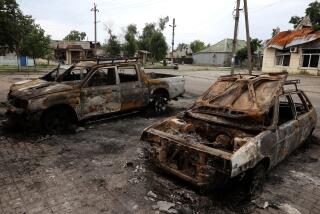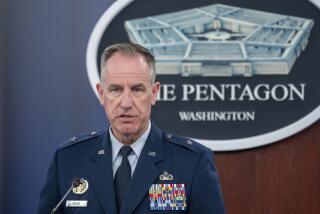Missiles supplied to Afghan rebels come back to haunt U.S.
WASHINGTON — When the Reagan administration made a controversial decision to send shoulder-fired missiles to Afghan rebels in 1986, critics warned the move could come back to haunt the United States.
In the hands of an anti-American guerrilla, Sen. Dennis DeConcini, D-Ariz., cautioned, a Stinger missile could turn a U.S. aircraft “into a bright orange inferno.”
Soon, that warning might seem prescient.
Taliban forces in Afghanistan still have about 100 U.S.-supplied Stingers, according to U.S. intelligence estimates, and the weapons are potentially well suited to destroy the helicopters that are expected to soon begin ferrying U.S. special forces into the country.
Although some of the missiles are probably defective because of age or rough handling, some military officials believe others continue to pose a deadly threat. In addition, the Taliban has purchased later-model Russian versions of the same weapon.
Experts note that the Afghans used them with such skill against the Soviets in the 1980s that the Stingers acquired the deadliest record against low-flying aircraft of any weapon since World War II.
The Taliban “does know how to use them,” said Clifford Beal, editor of Jane’s Defense Weekly, in London.
Developed by the U.S. Army in the 1980s, the Stinger is a 35-pound shoulder-mounted missile that uses an infrared sensor to locate an aircraft by its heat. The 5-foot-long missile travels at twice the speed of sound and destroys its target with fragmentation explosives.
The missile functions at low altitudes -- under about 4,500 feet -- and is not effective against aircraft traveling at low altitudes but high speed. U.S. forces have several countermeasures that can work against them, such as use of decoys. And the missiles are not as effective in night fighting.
Even so, they pose such a threat the U.S. government in the 1990s organized a buy-back program that offered as much as $100,000 apiece for the weapons. Some were returned, but many were not, because Afghan fighters consider them both an effective weapon and a status symbol.
In the 1980s, the U.S. government was sharply divided if the potential benefits of distributing the weapons to guerrilla allies in places including Afghanistan and Angola outweighed the risks that they could be used someday against the United States and allied countries.
The Stingers quickly proved their value when they were sent abroad.
By December 1986, only three months after they began reaching Afghan rebels, U.N. officials were estimating that “mujahadeen” fighters were destroying one Soviet aircraft a day. Because of the continuing toll they took, some analysts have given Stingers credit for turning the tide of the war against the Soviets.
In the coming engagements, U.S. special operations teams are expected to be combing Afghanistan’s rocky valleys and ravines for Osama bin Laden and the fighters who belong to his al Qaida network. Such operations will force them to fly low over their targets; in the 1980s, the Soviets often were forced to shift from high altitude to low altitude flights to find their rebel targets in the rough terrain.
The Stinger’s effective range is about three miles.
Beal said a key question is how well U.S. forces have improved the countermeasures they use against Stingers.
U.S. aircraft carry decoy rockets that are fired at intervals to provide a heat source that fools the Stinger. The military also has developed powerful strobe lights that throw off the Stingers’ sensors.
And U.S. forces can make it tougher for Stinger operators by flying at night. If the Stinger operator can’t see the approaching aircraft and launches at the missile at an that angle that takes it far from the aircraft, its chances of striking the target are reduced greatly.
Analysts warn that U.S. aircraft also will be at risk because of the hundreds of anti-aircraft guns held by the Taliban.
U.S. officials stress, however, that there is a lot they don’t know about the Taliban’s military capacity, and its air defenses in particular.
More to Read
Sign up for Essential California
The most important California stories and recommendations in your inbox every morning.
You may occasionally receive promotional content from the Los Angeles Times.











